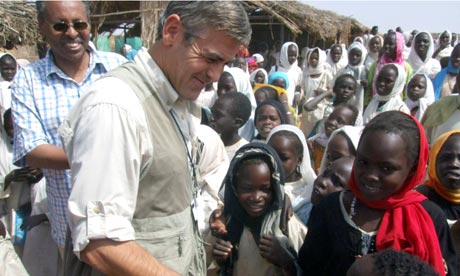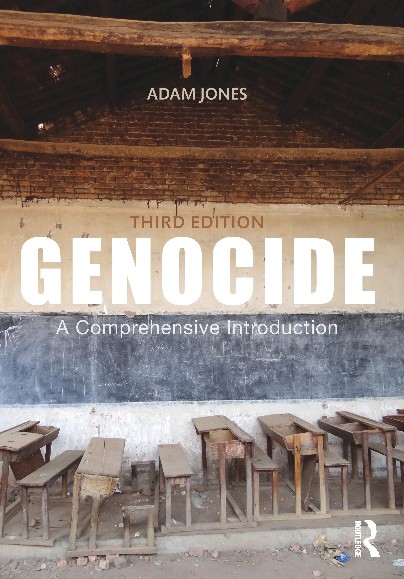 |
| "George Clooney on a visit to the Zamzam refugee camp in north Darfur in 2008." (Sherren Zorba/AP) |
By Paul Harris
The Guardian, March 24, 2012
"Nathaniel Raymond is the first to admit that he has an unusual job description. 'I count tanks from space for George Clooney,' said the tall, easygoing Massachusetts native as he sat in a conference room in front of a map of the Sudanese region of South Kordofan. Close by, pins and ink scrawlings on the map detail the positions of Sudanese army forces and refugee populations in the troubled oil-producing province, where the Sudanese army is carrying out a brutal crackdown. The wall next to Raymond has a series of satellite images projected on it. At the flick of a mouse, tiny images of tanks and military vehicles hove into view, caught by a satellite hundreds of miles above. Raymond is director of the Satellite Sentinel Project (SSP), which aims to use advanced satellite imagery to monitor potential human rights abuses in Sudan. And it was all Clooney's idea, turning him from just another Hollywood liberal with a pet cause to a genuine expert and campaigner on Sudan. Together with John Prendergast, another campaigner, Clooney has sneaked repeatedly into the country to document the random bombing of civilians and other atrocities. After a trip last month to the Nuba mountains, Clooney dodged rockets to return with grisly footage of corpses, children with missing hands and entire villages forced to live in caves. He showed the film to the Senate foreign relations committee in Washington DC -- to great praise from the assembled politicians -- then got arrested at a protest outside the Sudanese embassy. Images of Clooney being taken away in handcuffs appeared in newspapers and on blogs around the world. But it is in the day-to-day work of the Satellite Sentinel Project that Clooney's impact is really being felt.
He came up with the idea, and spoke to Google and the satellite company DigitalGlobe to help set it up, and he donates hefty speaking fees to keep it funded. It has been up and running now for 15 months. The situation in Sudan is complex and violent. Ever since the mostly-black African South Sudan gained independence from the Arab-dominated north last year border disputes have flared, especially over the region's oil resources. Meanwhile, powerful figures in the north fear that provinces along the southern border with its new neighbour may also seek to break free of Khartoum. The army crackdown is aimed at discouraging such hopes, or even changing the ethnic mix of the area in favour of those groups who that want to stick with Khartoum. Based in a nondescript suite of offices near Harvard Square in the Boston suburb of Cambridge, Raymond heads a small team of staff and student volunteers who monitor events on the ground in the heart of what is practically a war zone. Every day Raymond and his staff meet in what is dubbed the 'situation room' and news and reports from Sudan are analysed. They also pore over satellite pictures and compare them with a database of previous shots, looking for changes such as new military roads or camps, or troops on the move. ... SSP's work was initially conceived as mostly gathering evidence that might be used in any future war crimes tribunal for Sudanese leaders. But the imagery was so accurate that it could also be used to monitor claims about massacres and mass graves. After someone on the ground described watching bodies being buried in a mango grove in the town of Kadugli, SSP was able to document the site from the air. It also uncovered what appeared to be body bags lying in freshly dug pits elsewhere in the town. It has also shown troops surrounding towns and burned villages. In one astonishing set of images, it even captured an Antonov transport plane -- from which Sudanese forces regularly roll out bombs -- caught in mid-flight with plumes of smoke rising where the explosives had been dumped on civilian targets. In September last year, the group's analysis revealed what appeared to be an imminent attack on the town of Kurmuk in the Blue Nile province. Photographs revealed at least 3,000 troops equipped with tanks, artillery and attack helicopters. That prompted SSP to issue a warning, giving an opportunity for many to flee. For Raymond and his team, it was a turning point: they were no longer just observers, but were able to have an impact. For a humanitarian group operating thousands of miles away from the crisis, this was new territory. [...]"














This comment has been removed by a blog administrator.
ReplyDelete